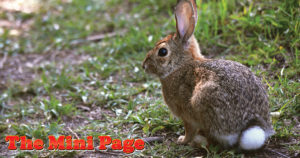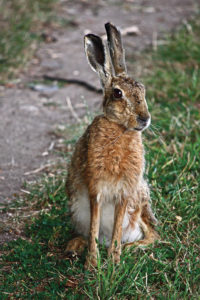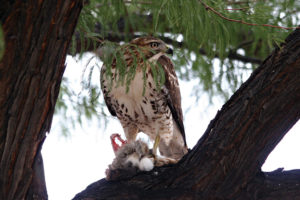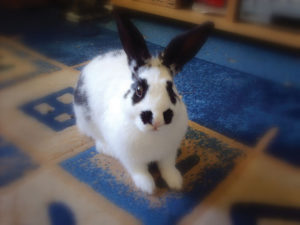
AMP | Kids is proud to partner with The Mini Page, celebrating over 50 years of providing engaging and fun learning opportunities to young readers across the country. This feature was originally syndicated in newspapers the week of April 4 – April 10, 2020. It is distributed digitally here with permission from Andrews McMeel Syndication. Enjoy and share with the young learners in your life!
Lots of kids have stuffed animals at home. One favorite is a bunny. In fact, some kids have real bunnies as pets.
Rabbits, both stuffed and alive, seem cuddly with their soft fur, long ears and twitching noses. To celebrate the arrival of spring, The Mini Page takes a closer look at rabbits.

A hare.
Rabbit or hare?
You might think the words “rabbit” and “hare” describe the same animal. In fact, there are big differences between rabbits and hares.
- Rabbits are born without hair and are blind. Hares are born with fur and with their eyes open.
- Hares are usually bigger than rabbits and have longer legs and ears.
- Hares can usually run faster than rabbits.
- Some rabbits live in underground burrows, while hares have their nests above ground.
Wild rabbits
Many thousands of years ago, rabbits could be found only on the continents of Africa and Europe. Today, they live on every continent except Antarctica.
North American rabbits usually like to live alone. They can mate at any time during the year, but February to October is their main mating season. Male rabbits, or bucks, will fight over a female rabbit, or doe.
A pregnant rabbit builds a nest for her babies. She may have four or five litters of babies during a year, with five to eight kits in each litter. But rabbits have many predators, or other animals that hunt them, so many of the babies will not live to be adults.

This red-tailed hawk has caught a rabbit to eat.
What’s for dinner?
Rabbits look for food at night. During the day, they hide in their nests and sleep.
Plants, including vegetables, grasses, clover and even tree bark, are their favorite foods. Four sharp front teeth (two on the top, two on the bottom) help them bite through tough plant stems and leaves.
A wild rabbit eats quickly, then goes back to its safe nest. Next, it passes partly digested, or processed, food. It eats the soft droppings, which still have minerals important to the rabbit’s health. Then it passes the food again, usually outside its nest. The rabbit will not eat these hard, dry droppings.
 Rabbits at home
Rabbits at home
Rabbits may seem cute and cuddly, but just like any other pet, each has its own personality. Some rabbits play more than others; some are easily startled and might run away or bite when they’re scared. Having a rabbit as a pet requires a commitment, or promise, to take care of the animal and spend time with it.
Housing
Some people like to keep rabbits outdoors in a rabbit hutch, or cage. However, experts suggest that pet rabbits be kept indoors to keep them safe from other animals and bad weather.
Indoor rabbits need a cage with a litter box. They can be trained to use the litter box just like a cat.
Exercise
Rabbits should be let out of the cage to play, but experts say they should be supervised while they’re out. They like to play early in the morning and in the late afternoon.
Some rabbits chew on things they shouldn’t, such as carpet, electrical cords or baseboards, where the wall meets the floor. Make sure you watch them when they’re out of their cage!
Resources
On the Web:
At the library:
- Jackrabbits: North American Animals by Christina Leaf
Teachers: For standards-based activities to accompany this feature, visit Andrews McMeel Syndication. And follow The Mini Page on Facebook!
